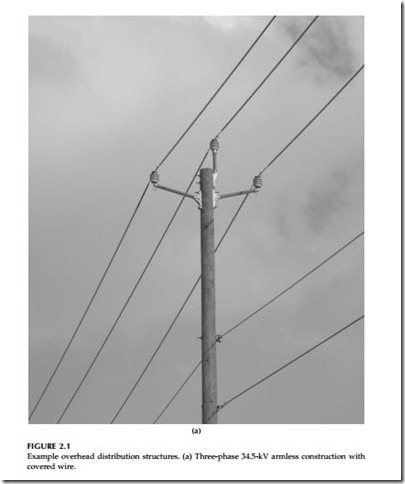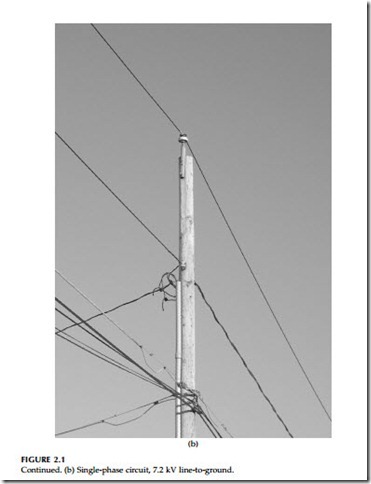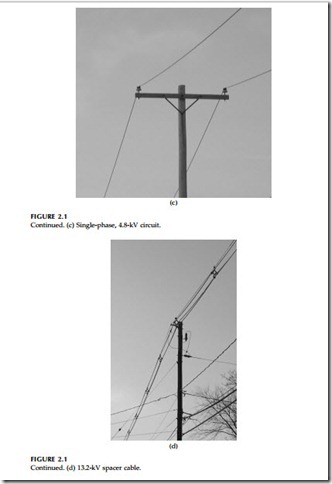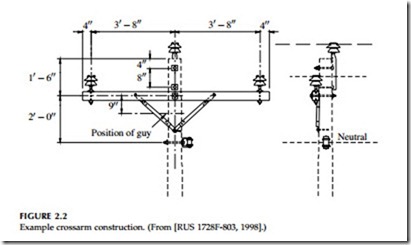Typical Constructions
Overhead constructions come in a variety of configurations (see Figure 2.1). Normally one primary circuit is used per pole, but utilities sometimes run more than one circuit per structure. For a three-phase circuit, the most common structure is a horizontal layout with an 8- or 10-ft wood crossarm on a pole (see Figure 2.2). Armless constructions are also widely found where fiberglass insulator standoffs or post insulators are used in a tighter configuration. Utilities normally use 30- to 45-ft poles, set 6 to 8 ft deep. Vertical construction is also occasionally used. Span lengths vary from 100 to 150 ft in suburban areas to as much as 300 or 400 ft in rural areas.
Distribution circuits normally have an underbuilt neutral — the neutral acts as a safety ground for equipment and provides a return path for unbalanced loads and for line-to-ground faults. The neutral is 3 to 5 ft below the phase conductors. Utilities in very high lightning areas may run the neutral wire above the phase conductors to act as a shield wire. Some utilities also run the neutral on the crossarm. Secondary circuits are often run under the primary. The primary and the secondary may share the neutral, or they may each have their own neutral. Many electric utilities share their space with other utilities; telephone or cable television cables may run under the electric secondary.
Wood is the main pole material, although steel, concrete, and fiberglass are also used. Treated wood lasts a long time, is easy to climb and attach equipment to, and also augments the insulation between the energized con- ductors and ground. Conductors are primarily aluminum. Insulators are pin type, post type, or suspension, either porcelain or polymer.
The National Electrical Safety Code (IEEE C2-2000) governs many of the safety issues that play important roles in overhead design issues. Poles must have space for crews to climb them and work safely in the air. All equipment must have sufficient strength to stand up to “normal” operations. Conduc- tors must carry their weight, the weight of any accumulated ice, plus with- stand the wind pressure exerted on the wire. We are not going to discuss mechanical and structural issues in this book. For more information, see the Lineman’s and Cableman’s Handbook (Kurtz et al., 1997), the Mechanical Design Manual for Overhead Distribution Lines (RUS 160-2, 1982), the NESC (IEEE C2- 2000), and the NESC Handbook (Clapp, 1997).
Overhead construction can cost $10,000/mi to $250,000/mi, depending on the circumstances. Some of the major variables are labor costs, how devel- oped the land is, natural objects (including rocks in the ground and trees in the way), whether the circuit is single or three phase, and how big the conductors are. Suburban three-phase mains are typically about $60,000 to $150,000/mi; single-phase laterals are often in the $40,000 to $75,000/mi range. Construction is normally less expensive in rural areas; in urban areas, crews must deal with traffic and set poles in concrete. As Willis (1997) notes, upgrading a circuit normally costs more than building a new line. Typically this work is done live: the old conductor has to be moved to standoff brackets while the new conductor is strung, and the poles may have to be reinforced to handle heavier conductors.



